
|
Soldering iron |
|

|
Soldering Iron Wire Welding Lead Roll |
Simple Inverters 12V to 220V , comparision, testing, and real characteristics
This time I will explain two of the simplest ways to make a 12V to 220V inverter, one with transistors and the other with Mosfet. Most often this type of inverters are made from parts of old PC power supplies.
At the end of the video you can follow the detailed way of making these inverters through many pictures. And now let's focus on the main purpose of this video to test the real capabilities of these devices.
The first test device is made with MJE13007 type transistors. These are NPN Bipolar Power Transistors which are designed for Switching Power Supply Applications.

For the consumer, I used an LED lamp with a power of 8 and 10 watts. We can trace the shape of the output signal before the output rectifier on the oscilloscope. In this case, the DC output voltage is about 240 Volts, and the current is about 8 milliamperes. With a small increase in the power of the consumer, the output voltage drops sharply. These are approximately the limit possibilities of this type of converter.
Next we will test an inverter made with IRF3205 mosfets. The circuit diagram is a bit more complicated, but the features are therefore better.

The DC output voltage is also around 240V and remains above 200V even with a load of 50 to 70 milliamps (10-15 watts). During long-term load, the mosfets remain cool.
If you want to make a PCB for this project, or for any other electronic project, PCBway is a great choice for you. PCBway is one of the most experienced PCB manufacturing company in China in field of PCB prototype and fabrication. They provide completed PCB assembly service with worldwide free shipping , and ISO9001 quality control system. Also, on their site there is an online gerber viewer where you can upload your gerber and drill files to render your board.

The most difficult part in making the inverters is to find out the correct terminals of the switching transformer. Here are some tips on how to do that. One side of the transformer always has only two active terminals and in our case it is always the secondary winding on which the high voltage is induced. On the primary (other) side there are usually more active leads. There is usually one thicker longer wire which always represents the middle lead. We can determine the other two terminals experimentally, and these are usually either the two middle terminals, or the two terminals at one end.

Based on the previous tests, follows a short conclusion. A common positive feature for both devices is that they use a minimal number of components, are extremely simple to build, require no setup, and almost always work immediately after assembly.
There are more negative sides
- Consumption at idle (no load) in both cases is very high.
- The output signal in these simplest versions is rectangular and high frequency and is not compatible with consumers who are dependent on these components.
- Claims that these inverters can provide 100 watts of power with just two transistors and more than 3000 watts with 12 or more transistors are fantasy.
With a 12V input according to Ohm's Law, in order to get 3000 watts at the output, we need 250 Amperes of current, and all this in case the efficiency of the circuit is 100 percent, which means there are no losses or heating.

The first device with 13007 transistors has almost no use value, except for a simple presentation of how switching devices work. At a load of only a few milliamps, the output voltage drops drastically, so that only a LED lamp of a maximum of 3 Watts can be powered.

The second inverter made with Mosfets is a bit more complicated and generally represents a ZVS driver circuit with several omitted components, since the supply voltage is limited to 12V. At the output, at a voltage greater than 200V, it can deliver a solid 10 watts (about 50 milliamperes) constantly, and in this case the total consumption of the circuit is about 18 watts. After rectifying and filtering the output voltage, this source is quite sufficient to supply the anode voltage for the EL84 Tube Amplifier. After rectifying and filtering the output voltage, this source is quite sufficient to supply the anode voltage for the EL84 Tube Amplifier.
However, if you need such an inverter, it is best to make one with an integrated circuit that is made specifically for this purpose, because in that case the output voltage is stable, often with a sinusoidal shape, and the efficiency is very high.

After all, the price of such inverters (which are very compact by the way) with an output power of about 50 Watts is lower than 5 dollars, so except for educational purposes or for pleasure, it is unprofitable to make such devices ourselves. One such inverter is presented in the picture above

Simple Inverters 12V to 220V , comparision, testing, and real characteristics
- Comments(0)
- Likes(1)
-
 Engineer
Jun 30,2023
Engineer
Jun 30,2023
- 0 USER VOTES
- YOUR VOTE 0.00 0.00
- 1
- 2
- 3
- 4
- 5
- 6
- 7
- 8
- 9
- 10
- 1
- 2
- 3
- 4
- 5
- 6
- 7
- 8
- 9
- 10
- 1
- 2
- 3
- 4
- 5
- 6
- 7
- 8
- 9
- 10
- 1
- 2
- 3
- 4
- 5
- 6
- 7
- 8
- 9
- 10
 More by Mirko Pavleski
More by Mirko Pavleski
-
 Arduino 3D Printed self Balancing Cube
Self-balancing devices are electronic devices that use sensors and motors to keep themselves balanc...
Arduino 3D Printed self Balancing Cube
Self-balancing devices are electronic devices that use sensors and motors to keep themselves balanc...
-
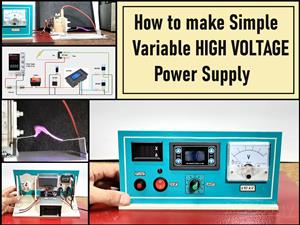 How to make simple Variable HIGH VOLTAGE Power Supply
High Voltage Power Supply is usually understood as a device that is capable of generating a voltage...
How to make simple Variable HIGH VOLTAGE Power Supply
High Voltage Power Supply is usually understood as a device that is capable of generating a voltage...
-
 DIY 5-Day Rainfall Forecast Device - ESP32 E-Paper Project
In several of my previous projects I have presented ways to make weather stations, but this time I ...
DIY 5-Day Rainfall Forecast Device - ESP32 E-Paper Project
In several of my previous projects I have presented ways to make weather stations, but this time I ...
-
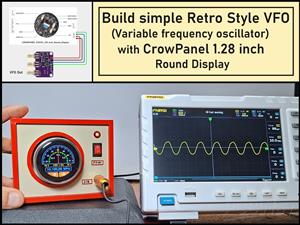 Build simple Retro Style VFO (Variable frequency oscillator) with Crowoanel 1.28 inch Round Display
Today I received a shipment with a Small round LCD display from Elecrow. The device is packed in tw...
Build simple Retro Style VFO (Variable frequency oscillator) with Crowoanel 1.28 inch Round Display
Today I received a shipment with a Small round LCD display from Elecrow. The device is packed in tw...
-
 Human vs Robot – Rock Paper Scissors with MyCobot 280 M5Stack
Today I received a package containing the few Elephant Robotics products. The shipment is well pack...
Human vs Robot – Rock Paper Scissors with MyCobot 280 M5Stack
Today I received a package containing the few Elephant Robotics products. The shipment is well pack...
-
 How to Build a Simple Audio Spectrum Analyzer with Adjustable Settings
An audio spectrum analyzer is an electronic device or software tool that measures and visually disp...
How to Build a Simple Audio Spectrum Analyzer with Adjustable Settings
An audio spectrum analyzer is an electronic device or software tool that measures and visually disp...
-
 How to Make a Digital Clock on a Vintage B&W TV using Arduino
These days I accidentally came across this small retro Black and White TV with a built-in Radio, so ...
How to Make a Digital Clock on a Vintage B&W TV using Arduino
These days I accidentally came across this small retro Black and White TV with a built-in Radio, so ...
-
 Build a $10 Function Generator with Frequency Meter for Your Lab
A function generator is a piece of electronic test equipment used to generate various types of elec...
Build a $10 Function Generator with Frequency Meter for Your Lab
A function generator is a piece of electronic test equipment used to generate various types of elec...
-
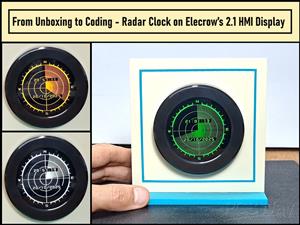 From Unboxing to Coding - Radar Clock on Elecrow’s 2.1 HMI Display
Today I received a shipment with a large round LCD display from Elecrow. The device is packed in two...
From Unboxing to Coding - Radar Clock on Elecrow’s 2.1 HMI Display
Today I received a shipment with a large round LCD display from Elecrow. The device is packed in two...
-
 Making a Retro Analog NTP Clock with Unihiker K10 - Arduino IDE Tutorial
Some time ago I presented you a way to use standard Arduino libraries on the Unihiker k10 developme...
Making a Retro Analog NTP Clock with Unihiker K10 - Arduino IDE Tutorial
Some time ago I presented you a way to use standard Arduino libraries on the Unihiker k10 developme...
-
 Build a Cheap & Easy HF Preselector - Antenna Tuner
HF antenna preselector is an electronic device connected between an HF radio antenna, and a radio r...
Build a Cheap & Easy HF Preselector - Antenna Tuner
HF antenna preselector is an electronic device connected between an HF radio antenna, and a radio r...
-
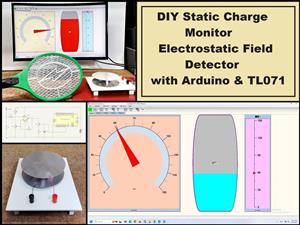 DIY Static Charge Monitor - Electrostatic Field Detector (Arduino & TL071)
A Static Charge Monitor also known as a Static Field Meter or Electrostatic Voltmeter is a device u...
DIY Static Charge Monitor - Electrostatic Field Detector (Arduino & TL071)
A Static Charge Monitor also known as a Static Field Meter or Electrostatic Voltmeter is a device u...
-
 XHDATA D-219 Radio Short Review with complete disassembly
Some time ago I received an offer from XHDATA to be one of the first test users of their new radio m...
XHDATA D-219 Radio Short Review with complete disassembly
Some time ago I received an offer from XHDATA to be one of the first test users of their new radio m...
-
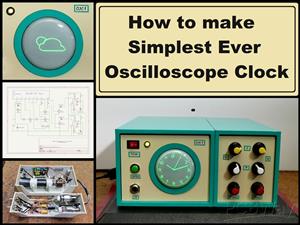 How to make Simplest ever Oscilloscope Clock
An oscilloscope clock is a unique and creative way to display the time using an oscilloscope, which...
How to make Simplest ever Oscilloscope Clock
An oscilloscope clock is a unique and creative way to display the time using an oscilloscope, which...
-
 DIY Digital Barograph with BME280 and ESP32 - 24 Hour Pressure Trends
A barograph is a self-recording barometer that continuously measures and records atmospheric pressu...
DIY Digital Barograph with BME280 and ESP32 - 24 Hour Pressure Trends
A barograph is a self-recording barometer that continuously measures and records atmospheric pressu...
-
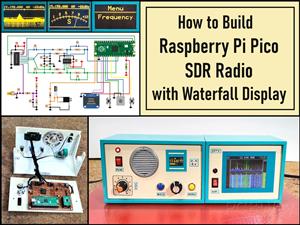 Build a Raspberry Pi Pico SDR Radio with Waterfall Display
Software-defined radio (SDR) is a radio communication system where components that have traditional...
Build a Raspberry Pi Pico SDR Radio with Waterfall Display
Software-defined radio (SDR) is a radio communication system where components that have traditional...
-
 DIY Magnet Polarity Detector - How to Identify Poles with a Hall Sensor from a PC Fan
Recently, while working on a project, I needed to determine the polarity of several permanent magne...
DIY Magnet Polarity Detector - How to Identify Poles with a Hall Sensor from a PC Fan
Recently, while working on a project, I needed to determine the polarity of several permanent magne...
-
 Light Meter Project - Making Dfrobot Unihiker K10 Work with Standard Arduino Libraries
The other day I received a shipment with a UNIHIKER K10 development board from DFRobot, which I rec...
Light Meter Project - Making Dfrobot Unihiker K10 Work with Standard Arduino Libraries
The other day I received a shipment with a UNIHIKER K10 development board from DFRobot, which I rec...
-
-
AEL-2011 Power Supply Module
553 0 2 -
AEL-2011 50W Power Amplifier
512 0 2 -
-
-
Custom Mechanical Keyboard
710 0 0 -
Tester for Touch Screen Digitizer without using microcontroller
340 2 2 -
Audio reactive glow LED wristband/bracelet with NFC / RFID-Tags
322 0 1 -
-
-














































